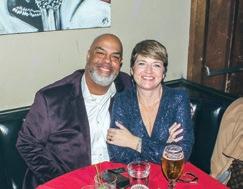The Wright Stuff
Wichita’s Sweetest Couple
IN THIS ISSUE:

Feed Your Valentine
Cactus Love
Clever Fashion Hack
























Wichita’s Sweetest Couple
IN THIS ISSUE:

Feed Your Valentine
Cactus Love
Clever Fashion Hack























• Find the Heart Diamond in the pages of this month’s SPLURGE! Magazine.

• Go to mikeseltzerjewelers.com and scroll to the bottom to register your answer.
• Like SPLURGE! and Mike Seltzer Jewelers on Facebook and/or Follow on Instagram.
• A winner will be chosen on February 14.
Mike Seltzer Jewelers is giving away these Diamond Star Studs to the winner of the February contest!

Congratulations to everyone who found the Heart Diamond on page 82 of the January issue. Chris Harrold of Wichita won the drawing and received a pair of diamond earrings from Mike Seltzer Jewelers!
12828 E. 13th N., Wichita, KS 67230 316.267.3678
Publishing Company Inspired Koncepts, Inc.
Owners Dr. Terry and Jody Klein
Dr. Dennis and Ann Ross
Steve Ruud
Publisher and President Jody Klein - jody@splurgemag.com
Vice President Amy Palser - amy@splurgemag.com
Associate Publisher Kelsey Ralston - kelsey@splurgemag.com
Editor Karen Long - proofing@splurgemag.com
Account Executives Kim Azaria - kim@splurgemag.com
Debi Devor-Mullins - debi@splurgemag.com
Accounting Firm of Esther M. Mollhagen, CPA
@splurgeict splurgemag.com
Graphic Design Mitch Gee
Contributing Writers Julie Underwood Burton, Alexis Evans, John Huthmacher, Julie Hying, Karen Long, Amy Palser, Natasha Park
Guest Columnists Nataliya Biskup, Nahid Holmes, Gregory Lakin, Eric Litwiller, Joseph Spaniol, Amy Sprole, Randy Yeisley
Editorial Photography Tobie Andrews
Fashion Photography Tobie Andrews
Stylist Lauren “L” Mercado
Local Faces Photography Michael Carroll Jr.
Illustrations: Elyse Schwertfeger
infringement of any third party’s rights therein, or for personal injury or any other damage or injury whatsoever. By placing an order for an advertisement, the advertiser agrees to indemnify the publisher against any claims relating to the advertisement.




A perfect retreat, the 145 scenic acres are heavily treed with four ponds, an abundance of wildlife, a custom-built estate home, attached and detached garages, an in-ground pool, full-sized tennis court, greenhouse, and a 61’ x 41’ outbuilding. Drive through the gate and up a paved driveway to a perfectly manicured setting. Pride of ownership shows throughout this pristine property. Rarely does a country oasis this special become available; don’t miss!

Individually, Angela and Don Wright each experienced 15 minutes of fame on the national stage. Together, they’ve built memories, a family, and a winning formula for true love and respect.


One look at the ups and downs of stock market graphs right now is enough to make anyone stuff their bills in a mattress. But our columnist Randy Yeisley has better ways to put your money to work.
18
After the passing of Ron Peake in 2018, his wife, Polly, had an interesting challenge: finding homes for his monumental collection of cacti measuring up to 10 feet tall. Four years later most of them are still flourishing.

If you’re tired of the winter uniform, this one weird trick will bring spark to your late-season wardrobe, says fashion columnist “L” Mercado. Plus, she gives us a sneak peek at fall 2023 trends.
Looking for some quick and creative recipes to warm the stomach of your loved one? Nothing says pure devotion like layered strawberry Jell-O cups, steak and lobster with herb butter, or a spicy chocolate liqueur.

 Written by Julie Underwood Burton
Written by Julie Underwood Burton
The Wrights are quite alike in some ways and different in others. Angela describes herself as more of a homebody, and says Don loves to be out — but it’s a formula that works for them. “He’s been a great influence on me to get out and have some fun and we’ve made such great memories, so I’m grateful I married such a fun guy,” Angela enthusiastically exclaims.
Asked what true love really is, Angela replies: “True love means being best friends and lovers at the same time. Don and I agree that our family always comes first, and I am appreciative he also respects that my career is very important to me. He always supports my hopes and dreams and, honestly, as a couple we just never want to burst each other’s bubble.”
He was Wichita’s most eligible bachelor — a title he earned from “People” magazine. She was a cover model with titles like Miss Venus International and Snap-on Tools Spokesmodel of the Year.

And while the future Mr. and Mrs. Wright were most certainly easy on the eyes, they were also both hardworking, successful business owners. Don Wright owned Wichita’s original soda fountain, Old Mill Tasty Shop, with his mom, Mary. Angela Razook was the 20-something founder of her own company, Answer Advantage.
When the two Wichita natives finally met, it was definitely a match made in heaven — and they have their parents to thank for it. The couple’s parents had been friends since the 1970s, and later Don and Angela would find themselves running into each other every so often. But on one special night in 2002, Don made a life-changing decision when he delivered a dessert to Angela’s table where she was seated with friends at YaYa’s Euro Bistro. The rest, Angela says, is history.
Angela was 29 and Don was 35 when they began dating, and the bond between them felt instant. It was significant for Angela because her dad had passed away when she was only 4; Don remembers her father well since he was a bit older than she. Within three weeks of that first date, Angela recalls Don telling her, “I know you don’t know this yet, but I’m marrying you.” One year after that infamous dessert serving, Angela and Don and 19 family members and friends traveled to their destination wedding in the Bahamas to celebrate their love and witness their vows on February 8, 2003.
They both believe that, from the beginning of their relationship, they felt a deep love and friendship and things were easy. “We were fully transparent and open with each other about our past, our expectations and what we wanted in each other. We have always had full trust in each other, and everything we felt in the beginning has become even deeper and more wonderful over our 20 years,” shares Angela.
Don and Angela together share a love for their hometown. “Wichita is a wonderful place to raise your family, plus there are terrific resources here and amazing people,” says Don. “We are both strong in our faith and take our faith seriously, and are also truly blessed to have such a great group of friends here with whom we love spending time together.”
The Wrights at their wedding in 2003


Before they met, Don and Angela each had their brushes with fame. Angela said she did a little modeling locally growing up, and when she was 18 entered a modeling contest at a Wichita restaurant/bar. “I won the local contest never thinking in a million years anything would happen,” she said. But that contest sent her on to the Venus Model Search, a bikini model competition that was part of a national pageant system. “I was just excited to go to Florida with my grandma, and then it was ridiculous that I won the whole thing,” Angela said with a laugh. She was crowned Miss Venus International 1992, a title that opened the door to modeling contracts over the next decade.
Keeping Wichita as a home base, Angela lived in L.A. and Florida for months at a time while she modeled for such media as Venus catalogs, “American Swimwear” magazine and “Fit” magazine, landing on multiple covers. She said she did her last modeling shoot 20 years ago while she and Don were dating. Meanwhile, a journalist who Don met nabbed him for “People” magazine’s Top 100 Most Eligible bachelors nationwide in 2000. “City girls need not apply,” said the magazine article. “This Mr. Wright relishes the simple things in life. Fitting then that he runs the historic Old Mill Tasty Shop in Wichita, a frozen-in-time soda fountain that froths up the same rich banana splits, malts and shakes it did in the 1930s.”


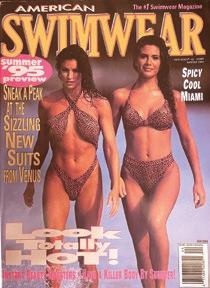
“He got a lot of attention that he did not love,” Angela said of the article.

While Angela didn’t initially want children, it was Don’s 6-yearold son, Keaton, that changed her mind, along with her own goddaughter, True. The couple later added two more sons of their own to the family, Brecken and Croix, now 18 and 16, respectively.

In addition to her full-time job as owner of Answer Advantage, Angela is a popular fitness instructor at the YMCA and credits the fact that, because they start their day with a workout at least three times a week, those workouts help them stay emotionally and physically strong as a couple. Don remains the well-known proprietor, along with his mother, of Old Mill Tasty Shop, which has been a beloved restaurant in Wichita since 1932 and gives him ample opportunities to gab with patrons.
And where do they like to dine? They love to eat out at locally-owned restaurants, but the “Wright Kitchen” seems to be a favorite as Don is known for his great cooking!
When asked about their best advice for others after 20 years of marriage, Angela quoted her grandmother: “Always remember that this too shall pass, and don’t sweat the small stuff.” And most importantly, for all couples dating or married, Angela says they agree the best advice is to strive to be 100 percent honest, and be sure to share all your needs, boundaries, wishes and dreams together.
Angela, Keaton, Brecken and Don Wright at the birth of Croix in 2006. Angela Wright’s modeling career started after her win as Miss Venus International 1992, landing her on the covers of multiple magazines.
For decades, Wichita has had first-hand involvement with the development of new drugs and treatments for a plethora of health conditions, from acne to Zika virus. The Alliance for Multispecialty Research (AMR), which has four sites in the Wichita area, has conducted thousands of clinical trials for new and advancing medications, both for use in the United States and worldwide. Many of the AMR-tested medications go to market, become commonly prescribed, and even help patients in Wichita experience improved quality of life.
Clinical trials are the tools researchers use to evaluate new medications and treatments for both safety and effectiveness, and are crucial for finding diseases earlier, discovering how to prevent problems and for enhancing the quality of life for those with a disease.
And clinic trials wouldn’t happen without willing volunteers. Tom McGraw of Wichita is one such volunteer who took part in an AMR trial in 2020 after reading about it in SPLURGE! The trial tested the ability of smart watches to track heart arrhythmias. For his part, McGraw wore an AMR-provided smart watch and a wireless cardiac monitor for several weeks. He was compensated for his time and efforts.
“I was a willing participant because I believe there is a great future for wearable diagnostics, and I felt my participation would help other patients, as well as possibly myself. The possibility of preventing a heart attack because of realtime data is amazing,” McGraw said. “I was really impressed with the interactions with the (AMR) researchers, which were all virtual. It was very professional and punctual, and they were very aware of my time.”
Patients taking part in a clinical trial can often get access to promising new approaches not otherwise available, and they receive regular and careful medical attention required by clinical trial protocols. “You could be the first to benefit from a new method of treatment,” said Dr. Terry Klein of Wichita, a partner at AMR.

But one of the most persuasive reasons to participate is a benevolent one: It helps others. Klein said many senior citizens take part in clinical trials because it’s a way to give back. “Many
of these treatments that have come out over the last 30 years have totally transformed people’s lives,” he said.

Malaria is one worldwide disease on which researchers have set their sights, fueled by the World Health Organization’s goal of reducing malaria 90 percent worldwide by 2030. A malaria vaccine being used in Europe hasn’t proven to be as beneficial as hoped, so the WHO rechallenged the industry to come up with alternative treatments and a malaria vaccination. “If we reach that goal, clinical trials will be the next step, and that will likely happen here in Wichita in the near future,” Klein said.
A drug’s journey from discovery to market occurs in four phases. Once created in a lab and placed into an appropriate carrier, the drug is tested for the first time on people in Phase 1. Given to a large group of healthy, young individuals, researchers monitor how it is metabolized in the system, discover the appropriate dosage and track possible side effects.
The U.S. Food and Drug Administration monitors every step of the clinical trial, and may request amendments before giving the green light for Phase 2. In that phase, about 50 to 100 participants who have the disease for which the drug is intended take part. Dosing is established during this phase. In Phase 3 thousands of participants receive the drug and report on side effects and outcomes. If the FDA approves this phase, the drug will be ready to go to market. Phase 4 is considered post-approval testing, where drugs already on the market are tested for other uses.
So, who can take part in a clinical trial? Klein said most everyone is a candidate for some type of trial, whether they are healthy or have a disease. Researchers need candidates of all ages and all points on the health spectrum. “Give us a call because there’s a high probability that you as an individual can contribute, whether with disease-specific research or gathering data from healthy individuals,” Klein said. “It’s important work, and we are so grateful to those who take part.”
For more information on clinical trials or to participate, visit heartlandresearch.com or call 316.689.6635.
Dr. Terry Klein



Have you heard the story about the contractor who was renovating a bathroom in 2006 and found $182,000 of Depression-era cash stashed in the walls? Or, what about the story in 2009 where a daughter gave her elderly mother a new mattress and threw out the old one, only to later find out that Mom had hidden $1 million of her savings in the old mattress? The moral of these stories is: Don’t hide money in places that you might not remember. It can be very easy to forget where you hide money.

In times of economic uncertainty, people are often tempted to pull their money out of the market and convert it to physical cash. This is where we get the phrase “mattress money” — cash that’s been stashed somewhere other than a bank or other investment vehicle. While this might seem like a good idea in the short term when the markets are down, it can have costly consequences. What happens if your wallet gets stolen? Credit and debit cards can be canceled and replaced, but any cash you had is gone for good. The same is true for money stashed in your mattress, in a wall, under the floorboards or buried in a tin can in the tomato garden. If your home is broken into or damaged in a fire or other natural disaster, that cash is likely not protected by renter’s or homeowner’s insurance. It’s just gone.
Your money is almost always safer in a federally insured institution. Here your money is typically protected for up to $250,000 per person. Even when interest rates are low, you still earn some interest when you keep your money in a savings account or money market account. A pile of cash just hiding somewhere in the house isn’t doing anything for you, except possibly attracting trouble. Aside from turning your mattress into a glorified piggy bank, what should you do when the market is too volatile for your risk tolerance?
The first thing to do is not panic. Making hasty, emotiondriven decisions will likely hurt you more than the market will in the long run. It’s almost always a good idea to consult a financial professional before making significant adjustments to your portfolio. You especially want to be aware of any potential tax consequences associated with moving money around. Finally, know that you have options. Depending on your income needs and risk tolerance, there are ways to build up and protect your savings without relying so heavily on the stock market.
For instance, you might decide you want to move a portion of money into less risky investments such as a fixed indexed annuity (FIA). These products are designed to protect your principal from market losses, while still giving you the ability to earn interest credits that are linked to the performance of a market index. Sometimes, these FIAs are used as a bond replacement in a diversified portfolio.
Another alternative you might consider is a multi-year guaranteed annuity (MYGA). A MYGA is the insurance industry’s version of a certificate of deposit. For the duration of the annuity contract, you are contractually guaranteed a fixed return. They’re generally shorter contracts than FIAs, and like an FIA, you don’t lose any money if the market goes down.
Whether accumulating a few extra dollars with a savings account, switching from bonds to FIAs with part of your investment portfolio or adding fixed-rate annuities to your portfolio, the most important thing to remember is to choose a vehicle that puts your money to work for you in ways that physical cash can’t. These are difficult times. Maybe you need a new advisor with an innovative approach.
Randy Yeisley is a local, independent investment advisor and is the founder and president of Yeisley Financial Group, Inc., located in northeast Wichita. He can be reached by emailing advisor@yeisleyfinancial.com or by calling 316.719.2900.


The passion and diligence of Bishop Moore, as he is now known, continues to enhance future learning and funding opportunities for the school. This past December, the academy was awarded a $500,000 Yass Prize from among 2,700 applicants from 49 states. The Yass Prize for Sustainable, Transformational, Outstanding, and Permissionless Education (STOP Awards) celebrates the nation’s education providers by disseminating over $11 million to 64 awardees.
Urban Prep was recognized, in part, for their “transformational, customized, personalized approach to education (that) provides individual assessment of each student to develop an individual learning plan to get students on grade level and beyond,” according to the Yass Prize website.
For information about the Yass Prize, go to yassprize.org. To learn more about Urban Preparatory Academy, go to upacademywichita.org.
Written by Julie Underwood BurtonWhen Wade Moore began looking toward his future as a graduate from his small rural Arkansas high school, his school counselor told him: “Kids like you don’t go to college.” Those were just the words he needed to hear that ultimately provided an incredible spark within to make a difference, not only in his own life, but in the lives of so many others.
After a solid career in the Army and later at Boeing, and with a college degree in hand, Moore’s career choices have done nothing but positively impact the lives of many Wichita families and children. After resigning his full-time managerial position at Boeing and other work as a full-time youth pastor, Moore decided it was time to dedicate his career to being a full-time pastor. By 2002, he started Christian Faith Centre in his basement, which is where he counseled numerous parents and families, and quickly recognized an immense need in Wichita for higher education opportunities, particularly for children. By cashing in his retirement funds and Boeing stocks, he personally funded Wichita’s Urban Preparatory Academy, worked diligently to lay the school’s groundwork, and was able to open the new school’s doors in 2014 to 13 elementaryaged children inside the former Mueller Elementary School near Wichita State University.
Today, Wichita’s Urban Prep is a private, tuition-based school whose mission is to provide children a quality education regardless of their family’s socioeconomic status. The school currently serves 125 students in grades kindergarten through eighth grade, and is known for working with students one-on-one to discover ways they can best learn. The academy’s primary principle, known as “Higher Learning Earlier,” focuses on preparing and empowering children with the necessary skill sets to function in a rapidly changing world.
A full range of computer learning opportunities are offered at the academy, plus there are performing arts classes and an athletic program where school-wide participation is encouraged with emphasis on sportsmanship and fair play. Curriculums also combine classroom education with online experiences, and include interactions with community businesses and leaders to help students learn about character, ethics, empathy and self-esteem.
Urban Preparatory Academy
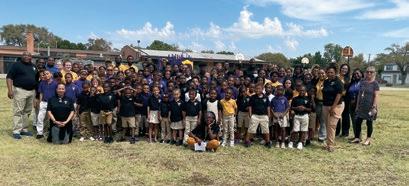
2821 E. 24th St. N. · Wichita, KS 67219 316.361.2469
admin@upacademywichita.org upacademywichita.org
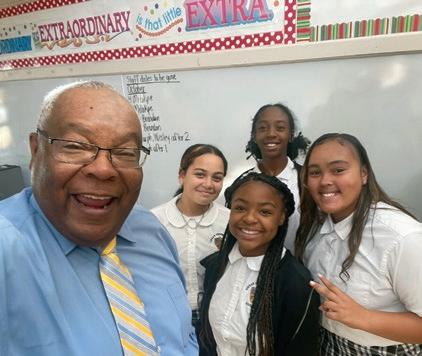
“Our goal is to open a second campus in south Wichita and offer the same educational experience to students who would not have this opportunity. We have been using the same technology since we opened our doors in 2014. The Yass Prize will give us an opportunity to update our technology delivery. We are a private school that provides full transportation to our students that need it. We hope to upgrade our transportation fleet to better serve our students and families!”
– Bishop Wade Moore, Founder/Dean Bishop Wade Moore poses with students at Urban Preparatory Academy

PHONE: 316.518.0028
EMAIL: landerson@weigand.com
WEB: lisaanderson.weigand.com
 Written by Eric Litwiller MHA Director of Development and Communications
Written by Eric Litwiller MHA Director of Development and Communications

Many of us probably spent the recent holidays with family. And — no matter your feelings about family members near and far — they often serve as an important connection to the world outside our homes, helping to avoid both the physical and emotional isolation which otherwise weighs upon mental health. But families can also be the mechanism that drives cyclical mental health concerns, either through genetics or through generational cycles of unhealthy behavior.
While families are comprised of individuals, it is also important to recognize them as a unit. If any one component of that unit is unhealthy, the entire family is likely unhealthy to some extent. And unhealthy families are more susceptible to negative patterns such as abuse, unsustainable financial habits, substance use and more. It is for these reasons that the Mental Health Association of South Central Kansas (MHA) maintains an entire division of programs to
treat the family unit. Breaking unhealthy cycles not only makes the families stronger, but also the Wichita-area communities in which those families live.
Our Adults and Families Division offers holistic programs designed to surround each member of the family with the mental health support needed for their individual circumstances. Without gaps or duplication of services, MHA provides family stabilization, employment programs, substance-use counseling (including tobacco cessation), talk therapy, school-based programs, case management and more. And because all those involved in the family’s treatment plan are under one roof, notes can be compared and progress discussed confidentially among the members of MHA’s staff who are involved in the plan. These programs remain available only as long as our entire community recognizes the value of these efforts. Visit MHASCK.org/invest to offer your support, or call 316.651.1241 to learn more about how you can help.
Thank you to Angel Culver, Realtor with JP Weigand & Sons, for her gracious support of this column and the MHA mission.




As a successful architect and builder, Ron Peake was known for his “sharp” sense of style when it came to building homes.
A longtime Wichita resident who grew up in New Mexico, his design–build firm flourished, thanks to what his wife, Polly, described as an artistic eye for detail. Peake, a father of two daughters – Michelle Howard and Patricia Peake, both of Wichita – died at age 71 in November of 2018. He had amassed an eye-popping personal collection of cacti sourced over nearly four decades, primarily from greenhouses and desert plains in Arizona and New Mexico.
When constructing his dream home on Wichita’s east side to accommodate his collection of cacti, he borrowed elements from an elaborate cactus garden incorporated into the design of The Phoenician, a luxury hotel resort located in Scottsdale, Arizona. Nestled comfortably in a thermostatically controlled environment, his cacti were lovingly arranged to complement one another, creating an eye-catching virtual desert display grounded in colorful shapes, sizes and textures.
“He just loved looking at them,” Polly said. “He was a very visual guy, and being an architect and builder, he blended lots of different shapes and textures to make it more pleasing. He wasn’t an expert; he just liked the look of them.”
“A neighbor who was a doctor kept his surgical kit at home because Ron was always running over to get a piece of cactus pulled out of him.”
– Polly Peake, wife of the late Ron Peake
Today his donated collection has mostly been divided between the Sedgwick County Zoo in Wichita, and the Southcentral Kansas Cactus and Succulents Study Group, an affiliate of Botanica. Their ongoing care proved too difficult and costly to manage, Polly said. “I tried to take care of them for a while. It cost $600 a month to keep them alive in the winter and I didn’t want to care for them. They were amazing, but not very nice.”
Certainly, Ron would not have faulted his wife of 39 years for finding them a new home. The danger factor involved in caring for cacti is quite high, a fact to which he could personally attest. On at least three occasions, Ron was injured badly enough by their sharp spines to require surgical attention. Workers who assisted him in relocating the cacti from a previous home in Wichita also sustained multiple injuries.
“A neighbor who was a doctor kept his surgical kit at home because Ron was always running over to get a piece of cactus pulled out of him,” Polly said. “Guys who worked for him had to go to the emergency room for cactus injuries also. They (cacti) are not very friendly.”
Ron’s fascination with cacti stemmed from his time spent living in southwest New Mexico as a youngster. His love of all things

southwestern was often reflected in his work, including design elements incorporated into his own garden oasis built in 2003. Though a longtime recreational runner, Peake was plagued with multiple health challenges through most of his life. In addition to surviving a bout with polio as child, his laundry list of afflictions included a disintegrated disc in his back that required surgery, and open-heart surgery exacerbated by steroid use to treat a cat bite. Dealing with these challenges left him with an even deeper affinity for cacti and how they are able to withstand the challenges posed by their harsh desert environment, Polly said. “He could relate to cacti as survivors because he was a survivor,” she said.

It was at the suggestion of friends that Polly contacted the zoo to offer Ron’s collection for display. She would later donate what plants were left to the Southcentral study group. Through her donations, Polly feels her late husband’s cactus collection is touching more lives than ever. This, in contrast to when only a few were able to view the private collection. “This way, it continues on,” she said. “We really were the only ones who were able to appreciate it in our home. This way, other people can.”
Certainly, zoo horticulturist Tyler Seneff was touched by the Peakes’ generous donation. A fellow cactus lover, he arrived to assess the collection in its carefully crafted desert oasis during summer of 2019.

“It was kind of surreal,” Seneff said of Peake’s garden paradise. “He literally had a house connected to his greenhouse, with really high ceilings and huge glass windows so he could see the oasis he made. I couldn’t believe how awesome that was. It was jaw-dropping for me.”
Moving the cacti proved a monumental task to zoo officials, though Seneff said he was more than up for the challenge. From barrel cacti standing 15 feet tall to smaller rare desert plants, the selection process was perhaps the most agonizing part of all. ”It made me gush seeing all the different plants he’d collected. We deal with a lot of donations, but nothing like that. It was one of those once-in-a-lifetime donations.
“I wanted to take 100 percent of them, but there was just so much in there, and cacti are not easy to transport, with all their spines and whatnot.”
“He was so overcome with emotion that he started crying,” Polly said. “We were so excited that they were able to come in and get what they needed and wanted for the zoo.”
To Seneff, Peake’s cactus sanctuary was truly visionary, one he hopes to eventually replicate with a similar build of his own design. Having developed a fondness for cacti from age 5 through ongoing exposure to a neighbor’s elaborate cactus garden, he now envisions fashioning a similar space to display his already ample collection of cacti.
Three truckloads later, the move was complete. Among the more memorable varieties accepted were a bright red desert bird of paradise, several three-foot-wide golden barrel cacti, three large saguaro (native to Arizona) cacti measuring approximately 10, 6 and 3 feet tall, and an assortment of some leafy jade succulents.
“I think the craziest part of it was how full it was,” Seneff said. “It was such a big greenhouse and he had it completely full, jammed packed with beautiful, lush cacti. It was quite a sight.”
“I wanted to take 100 percent of them, but there was just so much in there, and cacti are not easy to transport, with all their spines and whatnot.”
– Zoo horticulturist Tyler SeneffBuilder Ron Peake constructed a greenroom adjacent to his dining room to house his extensive cactus collection.
Kept alive in the zoo’s greenhouse in winter months, the cacti are replanted each spring to be viewed in a themed habitat. Plans are to relocate the collection to a high traffic south-facing slope situated between the zoo’s penguin exhibit and new train tunnel.
“My objective is that whenever somebody comes to the zoo, I want them to feel like they’re not in Kansas anymore,” Seneff said. “I want the cactus garden to feel like it is in the southwest United States.”



To that end, Peake’s plants figure to remain a vital visual aid to the zoo’s transformational portal for years to come, Seneff said. An estimated 75 percent of the donated cacti collected are still thriving after more than three years in their new surroundings.

“I’ve seen a lot of desert exhibits around the country — and even Germany — and what he had was amazing for a house,” Seneff said. “Very awesome.”
In a 2014 episode of “Hatteberg’s People,” Peake showed photojournalist Larry Hatteberg around his dining room-adjacent greenhouse, and spoke what has proven to be a prophetic statement. “Those plants are going to be here long after I’m gone,” he said. For daughter Michelle, that fact is a source of comfort to her and the rest of the Peake family. “He poured out so much of his energy into it, and that was something that gave him purpose in seasons that were really hard,” she said. “It’s a gift for them to be in a place people can enjoy them. It would delight him to know that people beyond our family are getting to enjoy them. He just thought they were beautiful.”

Q. You are originally from Nebraska. What brought you to Wichita?

A. I moved to Wichita in 2018 from Lincoln, Nebraska. I started my nonprofit career working for the American Cancer Society after my dad passed from cancer in 2013. In 2018, I was recruited by a retail company opening in Wichita to manage their community relations and events. A part of my role was to work with nonprofits and raise funds for their organization.


Q. Tell us about your role within the American Heart Association.
A. As the senior director, my role is to raise awareness and funds, and to recruit volunteer leadership to expand our footprint in the community. I manage our local development team who reaches the community through our fundraising events: Heart Walk, Go Red for Women and Heart Ball. Our mission is possible because of corporations and individuals who want to invest to make Wichita a healthier place to live, work, play and pray.
Q. How does the American Heart Association give back, not only to our nation, but also our local community?
A. Our mission is to be a force in empowering people to live longer, healthier lives. We address this by influencing the system of care in our community. The American Heart Association is committed to driving equitable health impact in Wichita through five areas: women, COVID-19, tobacco and vaping, patients, and healthy living. Through our focus on these key areas, we can improve the health and well-being of Kansans while saving and improving countless lives.
In short, the dollars invested in research and guidelines come back to our community. They are the practices your health care providers are following to administer treatment plans for patients. For the past 20 years, medical professionals have been using Get With The Guidelines (GWTG) to apply the most up-to-date, evidence-based treatments. This program engages hospitals and providers to improve patient outcomes through guideline adherence. Two Wichita hospitals participate in at least one GWTG quality improvement program.
In 2021, the American Heart Association invested $1.3 million in Kansas through research. Each year, investigators from a wide array of disciplines look to the American Heart Association to fund their ideas, but the available dollars simply aren’t enough
With Heather Smart Senior Director American Heart Associationto support them all. The American Heart Association received 2,027 applications, totaling more than $700 million in unfunded research — research that could save lives. People are counting on us as never before. Together, we will drive change, and we will be relentless.
Q. Tell us about the Heart of Wichita and the Heart Ball.
A. The Heart of Wichita is a year-round initiative that gathers local community members to join the fight and make a difference right here at home. Efforts are focused on driving equitable health for every member of our community. The Heart of Wichita campaign culminates at the annual Wichita Heart Ball celebration, marking a moment in time to reflect, honor and celebrate the progress made through the determination, dedication and passion of all who support the Heart of Wichita.
Join us for a fabulous and inspiring evening at the Wichita Heart Ball, February 11. Enjoy a gourmet dinner, exciting live and silent auction selections, entertainment, an after party and more during this unforgettable evening. See the work of the American Heart Association come to life and join us in our important, life-saving work.
For more information on how to reserve your spot at the Wichita Heart Ball, or other ways to support the American Heart Association, visit heart.org/wichitaheartball or contact Heather Smart, heather.smart@heart.org.












 David and Esther Mollhagen
WSU dance team members Bella Shibley, Ashley Page, Britney Gowan and Madelyn Marshall
Shocker student section – Camille Reid, Hayli Meier, Kyla Gordon, Jaileigh Erby, Denazhia Williams and Aaron Schiff
WSU Textron Men Project
Gavin, Averie, Alivia and Jaclyn Dewey
Donna Robson, Kim Azaria, Alan Nelson and Greg Robson
Teri and Mitch Gee, Michael Funke, Brandi and Tony Blake
Ziggy’s Pizza crew
Michael O’Donnell, Mimi and Tony Wakim, Jody and Terry Klein, Jessika and Justin Mayer
Shane and Jacqueline Raymer, Joy and Tom McGraw, Max, Amy, Brian and Jude Palser
“Circle of Brilliance” – WSU alumni and boosters
David and Esther Mollhagen
WSU dance team members Bella Shibley, Ashley Page, Britney Gowan and Madelyn Marshall
Shocker student section – Camille Reid, Hayli Meier, Kyla Gordon, Jaileigh Erby, Denazhia Williams and Aaron Schiff
WSU Textron Men Project
Gavin, Averie, Alivia and Jaclyn Dewey
Donna Robson, Kim Azaria, Alan Nelson and Greg Robson
Teri and Mitch Gee, Michael Funke, Brandi and Tony Blake
Ziggy’s Pizza crew
Michael O’Donnell, Mimi and Tony Wakim, Jody and Terry Klein, Jessika and Justin Mayer
Shane and Jacqueline Raymer, Joy and Tom McGraw, Max, Amy, Brian and Jude Palser
“Circle of Brilliance” – WSU alumni and boosters




Painful and often disabling, venous insufficiency causes problems for millions of people. It happens when the veins in your legs keep blood from flowing back up to your heart. When your valves don’t work well, your veins dilate, widen and stretch. Venous insufficiency can also cause blood to pool and collect in your legs. Untreated, patients may suffer from increased pressure in their legs, pain, swelling, leg cramps, bulging veins, changes in skin color, varicose veins and leg ulcers.
At PSC Vein Care, we treat venous insufficiency, varicose veins and spider veins, which can be both a cosmetic issue and a medical concern requiring attention. Our experienced staff uses vein mapping to evaluate veins and create a treatment plan. Vein treatment options include the following.

• Radiofrequency ablation (RFA) uses heat to close the saphenous veins that contribute to varicose veins in the legs. It’s a clinically proven, minimally invasive procedure that treats superficial varicose veins and chronic insufficiency with little or no discomfort or downtime.
• With sclerotherapy, we inject your veins with a solution that causes your blood vessels to close and dissolve. Sclerotherapy is the primary treatment option for spider veins.
• Phlebectomy involves removing medium to large varicose veins through tiny skin punctures that don’t require stitches. This procedure is minimally invasive and used for veins we can’t treat with sclerotherapy.
If you’re interested in discussing your vein treatment options, your first step is a consultation with one of our vein specialists. Call 316.688.7500 to schedule your appointment .
Our patient, Tenley, had radiofrequency ablation of the great saphenous veins on both legs.
Explain your journey to radiofrequency ablation.
Tenley: Ever since I had children, I’ve had leg pain. It was hard to stand or walk, and my legs swelled a lot. I also had large veins on the front and back of my legs that popped out. I visited with PSC Aesthetics, who referred me to PSC Vein Care. After a sonogram,
where they saw that the veins in my thighs were stuck open and pooling with blood, they diagnosed me with venous insufficiency. They recommended radiofrequency ablation followed by injections. Since I’d been a dancer, was a runner, had children, and had a genetic predisposition to venous insufficiency, I learned I needed to take care of this issue to prevent problems throughout my life.
treatment?
Tenley: They gave me something so I was less aware, plus lidocaine, and the pain wasn’t too bad. They treated one leg, followed by the other a few weeks later.
When did you notice a change?
Tenley: After the dressings and stockings came off, I noticed a shocking difference because I hadn’t done my other leg yet. I knew then that I could handle any pain on the other leg because it was so worth it, and my leg looked and felt great. A week after my second treatment I went on the best run of my life. My legs didn’t hurt, and I could breathe better, too. Are you happy with your results?
Tenley: Absolutely. Not only do my legs look better, but I can wear shorts without worrying about what my legs look like, stand for long periods of time, and walk longer without taking breaks. My clothes and shoes fit better because I am no longer swollen. The outcome is definitely worth it.
Do you have advice for people considering radiofrequency ablation?
Tenley: If your legs are in pain, are swollen, or have veins that pop out, please visit with PSC Vein Care. It was so nice to have the affirmation that something was wrong — and even better to know they could fix it. Venous insufficiency is a serious problem and can cause issues if you don’t take care of it.

Plastic surgery involves many choices; the most important is selecting a surgeon you can trust. Expect exceptional results when you have your procedures performed by plastic surgeons who are certified by the American Board of Plastic Surgery like Dr. Sprole, Dr. Biskup and Dr. Spaniol. These specially trained doctors have at least six years of surgical training and experience, with a minimum of three years of plastic surgery.Nousette Jefferson Photography | Instagram: @njeffphoto



 Written by Amy Palser
Written by Amy Palser
By the time he was 12 years old, Justin McPhillips was a full-fledged drug addict. It started with prescription drugs and marijuana and morphed into painkillers and illegal substances. “Anything I could get my hands on I would do,” he said. “It got worse as I was getting older, especially with the different crowds I was hanging out with.”
Once a serious athlete who wrestled and played football and baseball, drugs continued to consume Justin’s life and his talent. He quit sports and jumped from school to school, eventually graduating online and enrolling in barber school.
But his relentless addiction took an even more perilous turn after a friend introduced Justin to counterfeit pressed pills. They’re the fentanyl-laced drugs that have become the leading cause of death among adults ages 18–45. From April 2020 to April 2021, the U.S. recorded over 64,000 deaths due to fentanyl, a synthetic opioid that is 80–100 times stronger than morphine.
“Before pressed pills, my tolerance (to drugs) was so high that I could take a bottle of pills and still feel normal,” Justin said. “But I snorted a fourth of one pill and I was nodding off driving home. Going from taking 10 pills at once to only taking a quarter of a pill? To an addict that’s like finding treasure.
“After that I was fighting a whole different beast.”
Besides being more potent, the pressed pills were cheap. “I started buying more and more. A fourth turned into a whole pill, a whole turned into two, two turned into four. It gets to a point where you’re gambling with your life. Every day you’re waiting for something to happen. You could get a pill that has 10 percent fentanyl or 90 percent fentanyl.”
Today, Justin is thankful to be alive. So many others like him didn’t survive. “I’m grateful I’m here,” he said.
Justin quit barber school and was stealing to feed his heightened addiction. His mental health, already a concern, was deteriorating. His once athletic 6-foot frame shrank to 132 pounds. He overdosed on three or four occasions, sleeping for days, hallucinating and waking up covered in vomit.

It was after such an episode that Justin’s grandfather, who he was close to and often lived with, had a heart attack. Justin
heard his grandfather gasping in another room, ran to him and performed CPR. But the man he called “Poppy” was gone. That was Dec. 26, 2019.
“It was really, really, really difficult,” he said. “It hit me different. It hit me really hard staring death in the face. I thought, ‘What am I doing?’ I knew deep down this isn’t what I was supposed to be. Being there giving my grandfather CPR, I didn’t want my family to have to do that to me.”
So a month later, Justin decided to quit cold turkey. “Withdrawals were so bad on fentanyl. It’s like every sickness put together. I thought I was dying,” he said. “The first day I spent the whole day in the bathroom with everything coming out of me. For the next three days I was in my room with the lights off, tossing and turning, sweating, throwing up, having crazy dreams and hallucinating.”
Four days later he regained consciousness and knew he would need help staying clean. He went to Center for Change in Wichita, where Dr. Greg Lakin started him on Suboxone, a prescribed drug that blocks the effects of opioids and curbs cravings. When used in combination with therapy and education, opioid addicts have great success in breaking the addiction cycle for good.
Justin celebrated three years clean and sober at the end of January, and is enjoying every minute of it. He has a girlfriend who has been a great support to him, helping him get his first job out of recovery. Today he has a job helping addicts. “My biggest dream is to give my everything to the people who were there for me in my darkest days: my dad, my stepmom, my sister Candace, my sister Kelsie, my brother Jake, and my girlfriend. I say their names individually because they all played such a crucial role in helping me see the light.”
With a new shot at life, Justin wants to be an example to his nieces and nephews. “It’s hard for me to put into words the love that I have for all of my family,” he said. “The thing I’m most proud of is that I’m in the process of righting my wrongs. I want it to be known that this isn’t the end, it’s just the beginning.”
“After that I was fighting a whole different beast.” – Justin McPhillips on taking fentanyl
Providing professional one-on-one care in a private practice setting, Sarah specializes in both Adult and Pediatric speech disorders and sees patients with a variety of communication needs – with or without hearing loss.


Services include:

• Comprehension speech and language evaluations
• Treatment for pediatric speech and/or language delays
• Adult speech services for communication disorders
• Treatment for cognitive de cits due to strokes, traumatic brain injuries, head or neck cancer, or degenerative neurological conditions such as ALS or MS.

Immediate availability for appointments. Most insurance accepted.
















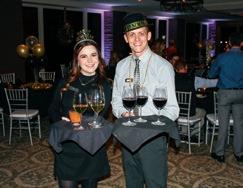

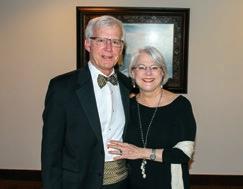 David and Kelly Bosarge, Wendy Veatch, Norma and Terry Allred
Mark and Nicole Campos, Aaron and Amanda Page
Cynthia and Greg Schlitter, Alan and Kristen Goodnight
Lucas and Steve Rospond
Kate Keller, Sarah Metz and Shelby Crowley
The Stark and and Dixon party
Grace Bolinger and Darin Conley
Mike and Sasha Kuchinski, Chris and Breana Hagan, Carrie and Mark Hagan
Kurt and Kelly Harper
Tracy and Amie Grafton, Colleen and Ed Sunquist, Marlys Bellamy
Jennifer Ruggles, Megan Henwood, Mercedes Hayes, Kristi Truitt and Janelle Norman
David and Kelly Bosarge, Wendy Veatch, Norma and Terry Allred
Mark and Nicole Campos, Aaron and Amanda Page
Cynthia and Greg Schlitter, Alan and Kristen Goodnight
Lucas and Steve Rospond
Kate Keller, Sarah Metz and Shelby Crowley
The Stark and and Dixon party
Grace Bolinger and Darin Conley
Mike and Sasha Kuchinski, Chris and Breana Hagan, Carrie and Mark Hagan
Kurt and Kelly Harper
Tracy and Amie Grafton, Colleen and Ed Sunquist, Marlys Bellamy
Jennifer Ruggles, Megan Henwood, Mercedes Hayes, Kristi Truitt and Janelle Norman
March 8, 2023
1 1 : 0 0 A M
W i c h i t a A r t M u s e u m
1 4 0 0 M u s e u m B l v d
S . J i m a n d D a r l a F a r h a G r e a t H a l l
T i c k e t s a r e $ 7 5
P r o c e e d s w i l l s u p p o r t e a r l y l i t e r a c y i n i t i a t i v e s i n K a n s a s
R S V P b y F r i d a y , M a r c h 3
F o r m o r e i n f o r m a t i o n , v i s i t S t o r y t i m e v i l l a g e o r g
John
RongishIt was at the Cosmosphere gift shop in Hutchinson that a 12-year-old John Rongish spotted a fellow Boy Scout whose sash was covered entirely in merit badges. It spawned a thought in the young Scout’s mind: What if he could earn every single Scout badge available? John spent the next five years of his life working toward that goal, earning his 139th badge at a ceremony in August 2022.

It’s a feat that only about 400 Boy Scouts worldwide have accomplished, requiring two regular sashes sewn together to hold all of the badges. “I don’t think it’s too super difficult to accomplish. I think earning one merit badge isn’t very hard, so it’s doing a fairly easy thing a ton of times,” said John, a junior at Bishop Carroll Catholic High School. “Every badge requires a different amount of work. You learn something new with each one, which is why I like doing it.”
Some of his favorites to earn were badges for small boat sailing, scuba diving, electronics, basketry and nuclear science. A few have even been life-changing: The Rongish family now has a dog thanks to John’s dog care badge. Communication was
another impactful badge. ”That changed me a lot and put me on a different course. I wasn’t a great speaker and I had to actively practice; I still do,” said Rongish, who is poised and pleasantly verbose.

John’s goal was to earn one badge a week, a time commitment of around five to ten hours. Today, with various levels of leadership within Boy Scouts, he spends 15 to 20 hours a week on Scouting endeavors. Having earned his Eagle Scout badge in 2020, he now participates in BSA-sponsored Sea Scouts, earning that program’s highest rank of Quartermaster. He is also a Lodge Chief for Order of the Arrow, Scouting’s national honor society.
“Scouting is the best thing a youth can do,” he said. “There are a lot of things you can learn through sports and clubs at school, but there’s a whole lot you’d be missing out on if you didn’t do Scouting. It prepares you for every situation in life. It is a ton of fun and you get to learn really useful things. It will change your life no matter what.”
Quivira Council and Morgan Stanley are proud to bring you Eagle Scouts in Action, a monthly showcase of community leaders who are banding together to make a difference in our community!
If you are interested in joining Scouting or have an Eagle Scout in Action you think deserves honoring, call us at 316.264.3386.

facebook.com/QuiviraCouncil www.quivira.org quivira_council198












 Ann Crow, Nancy Garvey and Barb Murphy
Laura Roddy, Patricia Thompson, Angie Mason and Cindy Hand
Jana Seabrook, Kathy Hammar, Katherine Munson, LewJene Schneider, Lindsey Coffey and Susan Kellerman
Naomi Shapiro, Melody Metulewic, Lily Ashcrome, LewJene Schneider and Leslye Woodard
Cindy Miller, Hazel Stabler and Kathy Bond
Becky Price, Marilyn Taylor, Maria Farha-Blewster and Nancy Garvey
Jody Klein, Mignon Brewster, Mimi Wakim and Jennifer Pitt
Susan Addington, Ruthie Williams, Monica McClure and Janet Razook
Derek Hever, Paige Meader and Gerald Woodard
Fawn McDonough, Jill Ward, Macaela Harris, LewJene Schneider and Brenda Munds
Nancy Knapp, Nancy Roberts and Eileen Kludt
Ann Crow, Nancy Garvey and Barb Murphy
Laura Roddy, Patricia Thompson, Angie Mason and Cindy Hand
Jana Seabrook, Kathy Hammar, Katherine Munson, LewJene Schneider, Lindsey Coffey and Susan Kellerman
Naomi Shapiro, Melody Metulewic, Lily Ashcrome, LewJene Schneider and Leslye Woodard
Cindy Miller, Hazel Stabler and Kathy Bond
Becky Price, Marilyn Taylor, Maria Farha-Blewster and Nancy Garvey
Jody Klein, Mignon Brewster, Mimi Wakim and Jennifer Pitt
Susan Addington, Ruthie Williams, Monica McClure and Janet Razook
Derek Hever, Paige Meader and Gerald Woodard
Fawn McDonough, Jill Ward, Macaela Harris, LewJene Schneider and Brenda Munds
Nancy Knapp, Nancy Roberts and Eileen Kludt




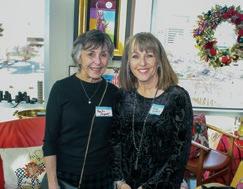






 Barbara Baan, Vedrana Barbir, Melody Matulewic, Sharon Mathis and Nancy Roberts
Patty Bennett, Kelly Monson, Linda Peressin and Helen Bullock
Marsha Geisert, Sierra Scott and Airin Rhinehart
Penny Moss, Manorma Khicha and Esper Tejano
LewJene Schneider with Deb and Angie Mason
Celeste Racette and Deborah Gafvert
Nancy Blanchat, Renee Pack and Laurie Drouhard
Terisa Olson, Betty Graham, Ashley, Nancy, Michelle and Andrea Lawrence, Maunie Stilwell
LewJene Schneider, Susan Gaddis and Courtney McKenzie
Linda Nugent and Pamela McGrath
Marya McCrae, Cindy Nutt and Dagni Anders
Barbara Baan, Vedrana Barbir, Melody Matulewic, Sharon Mathis and Nancy Roberts
Patty Bennett, Kelly Monson, Linda Peressin and Helen Bullock
Marsha Geisert, Sierra Scott and Airin Rhinehart
Penny Moss, Manorma Khicha and Esper Tejano
LewJene Schneider with Deb and Angie Mason
Celeste Racette and Deborah Gafvert
Nancy Blanchat, Renee Pack and Laurie Drouhard
Terisa Olson, Betty Graham, Ashley, Nancy, Michelle and Andrea Lawrence, Maunie Stilwell
LewJene Schneider, Susan Gaddis and Courtney McKenzie
Linda Nugent and Pamela McGrath
Marya McCrae, Cindy Nutt and Dagni Anders

We’re right in the thick of that time of year when the cold weather is monotonous and the sun waves goodbye by 5 p.m. Getting dressed for the day seems like we’re grabbing the same go-to’s: jeans or leggings, sweater, coat and scarf. The winter uniform, if you will.
I have a hack for you that will re-inspire your wardrobe and keep you fashion-forward for this season and beyond, and it starts with Fashion Week. Fashion Week happens twice a year in the major fashion capitals of the world: New York, London, Milan and Paris.
Spring/summer collections are shown to the press in September for the following summer. Autumn/winter collections are shown in February for the following winter. Designers work a season in advance to give previews of what’s to come, so buyers can prepare and manufacturing can begin. How does this help us, the consumer, if we want inspiration now for the season we’re in?
Don’t wait to use the collections debuting on the runways for the next season. You can do this by keeping an eye on emerging trends from the shows and working in those silhouettes, colors and textures. While you can’t get your hands on the actual designer pieces (because they aren’t mass-made yet), this is a fun way to re-imagine your current wardrobe and use next year’s looks walking down the runway as inspiration for your current style. Pay attention to hemlines, colors and overall silhouettes. You’ll be ahead of the game – and for the fashion-conscious, this is always the goal. You can use this method annually, in February and September!
Re-Imagined Tailoring Suiting has been on the scene for a while now, but suits with unique cutouts and oversized silhouettes – and even shorts – are the new suiting styles you’ll start seeing everywhere next fall.

Peplum Waistlines Do you have a few peplum tops hiding in your closet? It’s time to bring them back to the front. I never thought the peplum style would come back in style so soon, but if Chanel says peplum is back, I’ll listen!

Skirts Over Pants Yes, you read that correctly, and if you’re 30-plus you remember this trend of the 2010s and most likely have an old Facebook photo of yourself wearing this style. Katie Holmes brought the style back to life on the red carpet late last year, and now this trend is quietly making a comeback. This is a fun style to play around with this season and have it perfected by next winter!
Take a picture of this article, and tag us on Instagram (@splurgeict and @stylebyelle) and let us know if you’ll be keeping an eye on February Fashion Week!
Lauren “L” Mercado is a stylist and owner of Social Style. Follow her on Instagram at @styleby.elle






316.440.0772
Location – DŌMA
Photography - Tobie Andrews Photography
Models - Impact Models
Styling - Lauren “L” Mercado
Hair and Makeup - Crave Beauty Academy

Hair - Allison M, Kendra H, Madison S, ToyJaunna B
Makeup - Carmen S, Keila C, Kolsee D, Laura B



316.682.6784






316.779.6600


































































20% OFF
Any One New Spring Item.

SAM EDELMAN DRESSES, PISTOLA DENIM, CHINESE LAUNDRY, MARLYN SCHIFF, AG DENIM, FIVE AND TWO JEWELRY, SEE YOU SOON, TED BAKER, RAILS BAILEY 44, FRENCH CONNECTION, LAVENDER BROWN, AMANDA UPRICHARD, TART, VELVET HEART, MAURITIUS, PAIGE JEANS, HUDSON JEANS, 7 FOR ALL MANKIND JEANS, JOE’S JEANS, GREYLIN, LOVE TOKEN

316.440.0772 | Find Us On facebook.com/thelbdetc






Perfect Plate is here to help you achieve your goals, one healthy meal at a time!


Pre-order a meal plan or stop and shop for individual meals at one of our 3 convenient locations!


Gift card available. Always 100% gluten-free!


New Location

























We’ve got your Wichita cheat sheet of Valentine’s Day venues, from Scotch & Sirloin to pizza and beer, from a sultry nightcap to a sweet treat. Whether your beloved likes to swing a golf club or an ax, whether your gal pal is a vegetarian or a wine aficionado, make your Valentine’s list right here, check it twice, and enjoy!
These restaurants serve the best steak and other incredible dishes, as well as a pleasant ambiance for a memorable night out.
• 6S Steakhouse
• Scotch & Sirloin: Wichita’s Premier Steak House
• The Greens at Terradyne Country Club
• Chester’s Chophouse & Wine Bar
• Siena Tuscan Steakhouse
• Chisholm’s American Beef & Ale House
• Firebirds Wood Fired Grill
• Hangar One Steakhouse
Here’s a fun opportunity for you and your boo to get a little bit fancy. These Wichita classics deliver truly delicious meals and a gorgeous atmosphere, for the perfect romantic evening getaway.
• DŌMA
• The Belmont
• Georges French Bistro
• Newport Grill
• Napoli Italian Eatery
• Vora Restaurant European
• Albero Cafe
• Twelve Restaurant & Bar
Maybe you’re looking to keep it casual — whether it’s with your significant other or with a group of pals. Each of these spots will only give you the best, and you really can’t go wrong with a slice of pizza and a foamy brew.
• Ziggy’s Pizza
• Il Vicino Wood Oven Pizza
• Piatto Neapolitan Pizzeria
• Picasso’s Pizzeria
• Knolla’s Pizza
• Wichita Brewing Company
• Bricktown Brewery
• River City Brewing Co.
• Angelo’s Italian Restaurant
• Bronx Pizza + Pints
• Oak & Pie
Looking to make a night of it with some swanky cocktails? Wichita has some fantastic options for wine and beer taverns, check them all out.
• Alzavino Wine Tavern
• Dockum Speakeasy
• Central Standard Brewing
• Hopping Gnome Brewing
• Jenny Dawn Cellars
• Nortons Brewing Company
• PourHouse
• Tor Brewing
• The Anchor
• White Crow Cider Company
• Fleur De Vin
• Old School Tap House & Social
• Social Tap
• The Rusty Nail
• Whiskey Dicks
• Mort’s Martini & Cigar Bar
If you and your date are more partial to treats than alcohol, indulge your sweet tooth at one of these iconic shops, conveniently located throughout Wichita. Watch out for the sugar buzz!
• Cocoa Dolce
• Paris Baguette
• Milkfloat
• Frost Bake House & Creamery
• Churn & Burn
• Wichita Cheesecake Company
• Bagatelle Bakery
• La Galette French Bakery
For those with an old soul, visit these Wichita classics for some fantastic malts, shakes or cones.
• Jimmy’s Diner
• Papa’s General Store
• Old Mill Tasty Shop
• Doo-Dah Diner
• Delano’s Diner
For the couple who loves to get out and do, Wichita has plenty of fun places to get your energy going. You’ll certainly make a long-lasting memory at any one of these exciting places.
• Blade and Timber
• Topgolf
• Chicken N Pickle
• Dave & Buster’s
• Carousel Skate
• The Sandbox at Derby
• Axe to Grind
Of course, we can’t forget the Galentines! Brunch it up at these Wichita classics.
• HomeGrown
• Magnolia Café
• Wine Dive + Kitchen
• Dempsey’s Biscuit Co at Crutch BBQ
• Sweet Allie B’s and Limestone Beer Co.
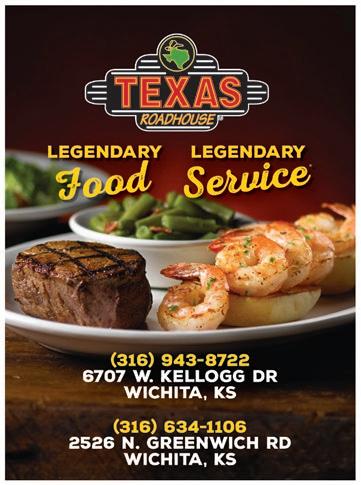








From thefirstyearblog.com
Ingredients
5 boxes strawberry Jell-O mix (3 oz. each)
2 cups Cool Whip plus more for topping (about 2 containers)
Strawberries to top each parfait
Water
Instructions
Layer 1: Combine 1 cup boiling water in a bowl with a packet of strawberry Jell-O mix. Stir until the mixture is dissolved. Add in one cup of cold water and stir. Evenly divide this mixture among the cups you’ll be using. Refrigerate until set, 1–2 hours.

Layer 2: Combine 1 cup boiling water in a bowl with a packet of strawberry Jell-O mix. Stir until the mixture is dissolved. Add in one cup of cold water and stir. Add in 1 cup of Cool Whip, and stir until mixed. Evenly divide this mixture among the cups you’ll be using, layering on top of the previous Jell-O layer. Separation may occur, causing a lighter and darker layer. Refrigerate until set, 1–2 hours.
Layer 3: Repeat Layer 1
Layer 4: Repeat Layer 2
Layer 6: Repeat Layer 1. Before serving, top each parfait with Cool Whip and a strawberry.
Total time: 11 hours
Servings: 6
From theinspiredhome.com
Ingredients
1 stick (or ½ cup) unsalted butter, softened
2 Tbsp. rosemary, minced
2 Tbsp. Italian parsley, minced
3 garlic cloves, minced
½ tsp. black pepper
Rosemary sprigs
Garlic cloves, whole
2 lobster tails, halved
2 filet mignon or New York strip steaks, at room temperature
Instructions
1. In a medium-sized bowl mix together softened butter, herbs, garlic, and black pepper until smooth and well incorporated.
2. In a shallow, medium-sized pan add 2 tablespoons of compound butter on medium heat until melted.
3. Sear lobster halves on each side for 1 minute. Add in another tablespoon of compound butter, turn lobster tails hardshell side down and place a lid over the pan.
4. Steam on medium low heat for 3–5 minutes or until shells have turned bright red. Serve with fresh lemon if desired.

5. While lobster is cooking, heat a separate medium-sized pan with 3 tablespoons of compound butter on medium heat. Add in a couple of peeled garlic cloves and rosemary sprigs to melted butter.
6. Season steaks generously with salt and pepper. Sear on each side for 2–3 minutes. Go a bit longer if you prefer your steak well done.
7. Cover steak with foil after cooking and let rest for 5 minutes before cutting into strips.
Total time: 20 minutes
Servings: 2
Illustrations by @elysessweetsFrom simplyhappenings.com
Ingredients
Approximately 1 lb. lobster tail (may take 2–4 tails depending on their size)
4 Tbsp. butter
1 cup diced carrots
1 cup diced celery
1 small yellow onion, diced
1 Tbsp. minced garlic
2 Tbsp. tomato paste
2 Tbsp. all-purpose flour
2 cups chicken broth
2 cups seafood/fish broth or reserve 2 cups of water remaining from boiled lobster tail
1 cup dry white wine
1/2 cup heavy whipping cream
2 thyme sprigs
2 bay leaves
1 tsp. salt
1/4 tsp. pepper
Instructions
1. Place lobster tails (in shells) in a boiling pot of salted water. Boil for about 5–7 minutes (depending on the size of tails) until the lobster tail turns bright red and the inner meat is no longer translucent and turns white.
2. Remove lobster tail from water and allow to cool in a colander. Remove fins from the end of the tail. Lay tail on counter and press down firmly on the outside of the shell to crack it. Remove meat with a fork. Cut lobster meat into chunks and set aside. Note: It’s okay if you find the lobster is not fully cooked after chopping it. It will cook through when added to the soup later.
3. Melt butter in a large pot over medium-high heat. Add carrots, celery, onion, and garlic. Cook 7–8 minutes until vegetables are softened. Stir in tomato paste and cook for 1 minute. Add flour and stir vegetables to coat.
4. Slowly add wine and stir to blend. Add salt, pepper, thyme sprigs, bay leaves, chicken broth, and seafood broth (or reserved lobster water) and bring to a boil. Reduce to a simmer and let cook for 15 minutes, stirring occasionally.
5. Remove thyme sprigs and bay leaves from pot. Using an immersion blender, blend soup until all vegetables are pureed and soup is smooth. Add heavy whipping cream and lobster meat and cook for an additional 5 minutes at medium-low heat.
Total time: 55 minutes
Servings: 5

From shekeepsalovelyhome.com
Ingredients
1½ cups unmelted chocolate
1 cup whole milk
1 cup heavy cream
1 cup tequila
½ 14oz. can of condensed milk, or a little less if your chocolate is very sweet
1 tsp. cayenne pepper
1 tsp. chili pepper, plus a little for garnish
Cinnamon for garnish
Instructions
1. Add the milk to a pan and heat on a low flame. After 5 minutes, add the chocolate and mix until melted.
2. Add the heavy cream, condensed milk and spices.
3. Mix and heat for another 10 minutes, stirring occasionally.
4. Add tequila and stir.
5. Pour into a bottle and refrigerate.
6. When serving, shake and pour through a strainer. Garnish with a few sprinkles of chili pepper and cinnamon.


Total time: 20 minutes
Servings: 3 cups

With a Korean War veteran for a father, Wellington recording engineer Carter Green found instant resonance with a documentary being made about the late Father Emil Kapaun, and knew he wanted to be part of the project. Now, Green owns an Emmy for his work on the film in conjunction with The Wichita Eagle.
“So there you go, an Emmy!” says Green, owner of Greenjeans Studios in Wellington for over 20 years. “Once Was Lost: The 70-Year Search for Father Kapaun,” won a Heartland Emmy in 2022 in the category of Documentary Program: Topical.
This documentary tells the story of the surprising and emotional recovery of the remains of Korean War chaplain and Pilsen, Kansas, native Father Emil Kapaun. The film was written and directed by The Wichita Eagle multimedia journalist Travis Heying and freelance writer Roy Wenzl. Green composed the film’s score, and Eagle visuals editor Jaime Green and Eagle executive editor Michael Roehrman were also recognized as producers of the film.
“I was asked if I would be interested in composing the original soundtrack for the film, and I said, ‘Absolutely!’ It’s a big story for not only the people of Kansas — he was from Pilsen — but also for American POWs, veterans and people of faith,” Green said.
Kapaun is credited with saving the lives of countless prisoners held captive during the Korean War. Recognized by the Roman Catholic Church as a Servant of God in 1993, his cause for sainthood continues to gain momentum as he approaches step two, Venerable, in the four-step declaration process.

Seventy years after his death in a prison camp, it was announced in March 2021 that Kapaun’s remains were identified, and on September 29, 2021, were entombed inside the Cathedral of the Immaculate Conception in Wichita within the Diocese where he was ordained.
“A lot of people in my life have been touched by Father Kapaun’s legacy, and to work on this film was such an honor, as if my whole career had led to this project,” Green said.
The Eagle’s Heying and Wenzl traveled to Honolulu; Houston; Washington, D.C.; and Dover, Delaware, to research and make the film, which took more than five months. The Eagle soon found out that the National Academy of Television Arts and Sciences, Heartland Chapter, had nominated the film for an Emmy in the best historical documentary category.
“We couldn’t believe we got the nomination,” Green says. “And then, to our great surprise, we won the Emmy for best historical documentary in 2022! We were flabbergasted! I never, never, imagined it could go that far. But I think the reason is because it’s such an emotional American hero story. It’s how we take care of our fallen heroes and bring them home to their families. And … it meant so much to everyone around here.”
You can find the full hour documentary telling the story of the 70-year search for Father Emil Kapaun at kansas.com/kapaun.
Holding Emmys for their winning documentary “Once Was Lost: The 70-Year Search for Father Kapaun” are Wellington composer Carter Green (left) and Wichita Eagle staff members Jaime Green, Travis Heying and Michael Roehrman.


It’s not goodbye, I’m just off to my new journey!
Chris Angel Gomez Celebrity Cruises Market President celebritycruises.comAs some of you may know, I have been tapped for my next career journey in South Florida with Celebrity Cruises, but I will forever have ties to Kansas, as I have learned how amazing our beautiful city of Wichita is. My current role is being transitioned to Scott Taylor, one of my amazing counterparts who is a native Midwesterner from Indiana. There are several celebrations being planned for our goodbye, so we hope to see everyone at some point before we leave. I wanted to take this opportunity to let you all know why we love Kansas so much.

During the last eight and a half years we learned how this community comes together to create impact, and that it has a thriving art community. We have collected art from so many extraordinary local artists that we will now showcase to our Floridian friends.
Kansas made us parents to an amazing baby girl named London. We have collected an amazing group of friends (they know who they are) that we will forever cherish and have as part of our lives. And we have learned the power of community here, and how everyone can set their differences aside to help make our community better. Please make sure you don’t ever change that, because it’s 100 percent OK to be different, yet together.
Lastly, a huge thank you to the local Celebrity Cruises leadership team, who helped take the team from 250 employees to 700 over the last eight and a half years. They also now manage a multibillion-dollar global operation, all in Kansas. This was accomplished with strong teamwork, tenacity, positive servant leadership and respect. When we work together, anything is possible — even running a cruise company from Wichita.
Carlisle, London and I humbly thank you all for being part of our journey, helping us propel our lives forward spiritually and faithfully.
Forever grateful,
Chris Angel GomezI’m a native Midwesterner, born and raised in a small town in central Indiana. I’ve been fortunate that my career has allowed me to live in places large and small, from coast to coast, and my family and I have settled in South Florida for the past 20-plus years.
My husband and I have a 12-year-old son who is the light of our lives. He loves the arts and is a musician, playing both the violin and piano. I love my work and am a sports fanatic. I’m a huge fan of my home-state (Indiana) sports teams, and I’ll soon become a fan of our very own Wichita State Shockers, and other teams based in Wichita. While I’ll continue to live in South Florida, I’m excited to be able to work with our amazing leadership team at Celebrity Cruises in Wichita, and to work with community leaders of Wichita and Sedgwick County.
Outside of sports, my passion is to help children and families. I’m dedicated to helping children have better lives, to ensure they are safe and have the resources to realize their full potential in life, and to help our families flourish.
Cheers!
Scott TaylorAt age 30, Kelsey Banwart, a former WSU volleyball athlete, was trying different workouts. She really got into the atmosphere of group fitness, vibing with the camaraderie and culture. But her joints became an issue. “I have rolled my ankle 1 million times,” she says, “so I was really looking for low impact workouts.”

When she and fiancee Dustin West, owner of Supplement World, heard about a bungee fitness business in Edmond, Oklahoma, they went down to check it out, and Banwart was immediately hooked on the exhilarating bouncing and soaring workout. “It was hard — but it was so easy on my joints. I didn’t wake up with back pain or aches in my ankle.”

On February 3 Banwart and West will throw a grand opening celebration for their new venture, Bungee Fit, near 29th Street and Rock Road, where steel reinforced beams were installed for each bungee station during renovation. Anybody who weighs 90 to 300 pounds is welcome, Banwart says, from young to old and everyone in between.
“We accommodate all shapes and sizes. The low impact will have the least amount of risk for you, and the greatest results. Here, you’ll find a community that’s going to support you and we’ll have fun doing it.”
Sometimes people will ask Banwart if it’s really a challenging workout; don’t the bungees do all the work? “That’s when I so politely invite them to come do a workout,” Banwart says, “I like to think I’m in shape, and these workouts will quickly humble you.” Bungee Fit will be open for classes on February 4. Go to bungeefitict.com for more information and to sign up for single classes or monthly memberships.
When Sanjaya and Kristina Perera, owners of Silver Spoons in Andover, wanted to branch out, it didn’t take long for them to put two facts together. One: They both loved crepes. Two: There wasn’t a single restaurant nearby for them to enjoy said confection. At the end of last year they opened Hot Berries Cafe, whipping up sweet crepes in a small building at 203 W. Central in Andover and offering them for takeout.
“We tried out many crepe and Belgian waffle recipes before we found what we really liked,” says Sanjaya. Before long they added savory crepes as well.
“All our hard work and weeks of preparation paid off. Soon, we saw how customers reacted to our products,” says Sanjaya. “Everyone liked it, and everyone gave us their honest feedback. I think that’s what’s great about Andover residents — they’re all about helping local businesses, and we are grateful to every one of them.”
Anyone who stops by this month for the Valentine Crepe will see what the buzz is about: It’s loaded with Hershey’s chocolate chips, pure honey and their very own Hot Berries sauce, all wrapped up in a soft, sweet crepe and topped with whipped cream cheese, chocolate syrup and more Hot Berries sauce.

Gluten-free and dairy-free crepes are a recent addition, and Sanjaya says he and Kristina are brainstorming more ideas for spring and summer, including — coming soon — chicken and waffles.
Here’s a sweet Valentine’s Day offer from Hot Berries Cafe: Buy one signature crepe and get the second half off. Follow them on Facebook for more information.
Belgian waffle with toppings
 Valentine Crepe
Photography courtesy Hot Berries Cafe
Photography courtesy Bungee Fit
Valentine Crepe
Photography courtesy Hot Berries Cafe
Photography courtesy Bungee Fit









As the calendar flips from January to February — yet another cold month — we look to the 14th of February, a celebration of love and friendship, to carry us along until the warm spring breezes arrive. What better inspiration as you weave plans to bring warmth to the heart of your loved one than a little history on Valentine’s past and ideas for Valentine’s future?
In the early part of the third century, Valentinius, a Roman priest and the former Bishop of Turni, helped young lovers marry when an emperor’s edict declared that single men made superior soldiers and forbade matrimony. Later that year Valentinius was martyred and became known as St. Valentine. Valentine traditions began as early as the sixth century in ancient Rome with Lupercalia, a festival to welcome the upcoming arrival of spring. In the 1700s in the American colonies, an early tradition of making and sharing handmade cards was enjoyed.
Later, in the 1840s, some of the first commercial valentines were printed in Victorian England, engraved or made from woodcuts. Lovely, elaborate cards detailed with lace, ribbons, gold and silver foil appliqués along with dried flowers communicated sentiments of love. Others were simply constructed of folded paper and sealed with wax. In the 1840s here in America, stationers began advertising their valentines in newspapers. Esther Howland of Worcester, Massachusetts, became an early forerunner in the creation of valentines featuring specific designs of paper lace.
In England by 1871, the General Post Office handled more than one million valentines. Hallmark began selling valentine cards in 1913. Today, American postal workers report that they handle more valentines than Christmas cards each year.

Candy makers and chocolatiers flourish in the season as well; Britain’s Cadbury company began selling heartshaped boxes of chocolate treasures. In 1807, the Hershey company of Pennsylvania first introduced the “kiss,” and trademarked it in 1921. By 1986, holiday-themed kisses were wrapped in pink and silver. Today, Valentine’s Day cards are still made, purchased and sent all over the world to friends and loved ones. Valentine crafts adorn our homes and classrooms. Card boxes are constructed to resemble anything within the realm of imagination: rocket ships, cupcakes, penguins, puppies. Small paper valentines and treats are deposited in these creative designs and shared with classmates and family members.
In addition to Valentine’s Day cards and candies, there are countless other gestures that express friendship and love.
A bouquet of roses — or even a single rose — in blossoms of red, pink or white whispers hints of romantic love. Classically elegant and always in season, roses aromatically call to mind thoughts of romance and love, leaving a special impression with the recipient.

Another fun idea to show love is to surprise someone with a visit or a gift. One frigid day in February, stop by the workplace of your valentine or a close friend to drop off a steaming cup of coffee or hot tea. Just holding the warm vessel will inspire that person’s heart and mind.
Time spent preparing a home-cooked meal shows affection, dedication and love. Layered, rich lasagna, creamy fettuccine Alfredo or perhaps a perfectly prepared filet mignon paired with a full-bodied red or a crisp white wine can be as pleasing and as appreciated as any meal served in an elegant restaurant in any city of the world. Meanwhile, many will commemorate the date with a night out and dinner at a fine restaurant. Either dining in or venturing out means enjoying delicious dishes together.
A thoughtful gift may warm someone’s spirits this Valentine’s Day. As winter winds blow frigid and chill, a cashmere or plaid flannel scarf — perhaps crocheted or hand-sewn — warms the body along with the spirit. Or treat a special someone to the relaxation of massage; it transcends the moment, offering stress relief and restored energy.
Whether selecting or making a special card to send, treating someone to a meal or hand-crafting a gift, the appreciation expressed will certainly call to mind Valentine’s Day and the centuries of tradition started by St. Valentine as a gesture of love.

 A vintage Valentine circa 1890
A vintage rose bouquet illustration circa 1881
A vintage Valentine circa 1890
A vintage rose bouquet illustration circa 1881

































